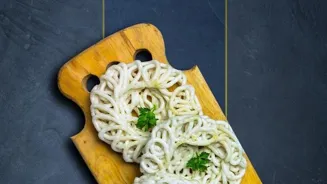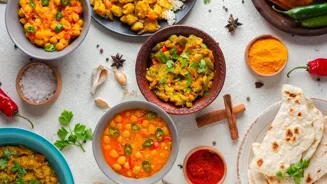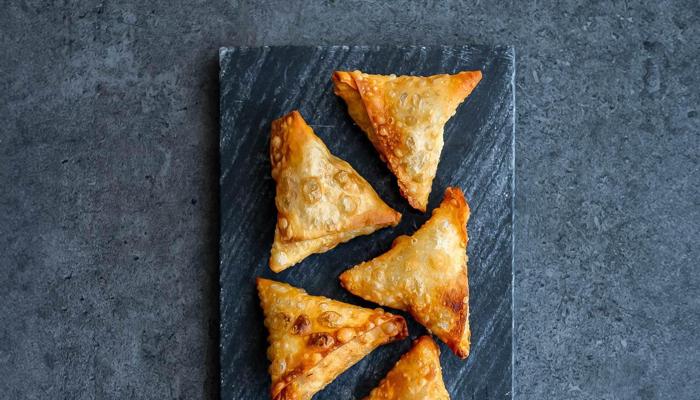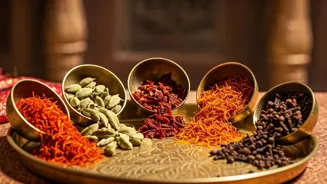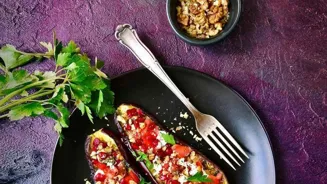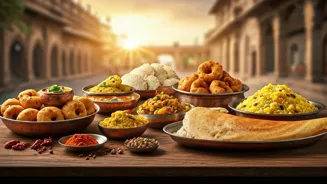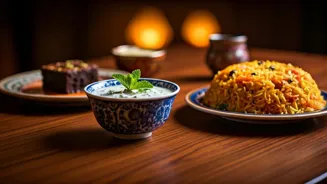Unleash the Art of Perfect Homemade Naan: Elevate Meals with This Indian Staple! Learn the secrets to mastering this pillowy flatbread
Naan, that soft, pillowy flatbread, is a staple in Indian cuisine.
Whether you're scooping up a flavourful vegetarian curry or simply enjoying it with a dollop of butter, a perfectly baked naan can elevate any meal. But making naan at home can seem daunting. Fear not!
With a few simple techniques and readily available ingredients, you can master the art of homemade naan and impress your family and friends. Forget those supermarket naans; the aroma and taste of freshly baked naan from your own kitchen are simply incomparable.
Key ingredients for perfect naan: flour, yeast, sugar, salt, yogurt, oil
The secret to incredible naan lies in understanding the key ingredients and their roles. Flour, of course, is the foundation. All-purpose flour works perfectly well, but for an extra touch of authenticity, you can use maida, a finely milled flour.
Yeast is the leavening agent, responsible for that airy texture. Sugar feeds the yeast, while salt controls its activity and enhances the overall flavour. Yogurt adds moisture and tang, contributing to the naan's characteristic softness.
Finally, a little oil keeps the dough pliable and helps create a tender crumb. Experimenting with different flours can also be fun! Try mixing in a little whole wheat flour for a nuttier flavour and added fibre.
Kneading creates chewy, airy naan; vital for gluten development
Kneading is arguably the most crucial step in making naan. The goal is to develop the gluten in the flour, creating a strong, elastic dough that can trap the gases produced by the yeast. This process gives the naan its characteristic chewiness and prevents it from becoming flat and dense.
Don't be afraid to get your hands dirty! Knead the dough vigorously for at least 8-10 minutes, until it becomes smooth, soft, and slightly sticky. A stand mixer can also be used, but there's something satisfying about the tactile experience of kneading by hand.
Remember that a well-kneaded dough is the key to a light and airy naan. Patience and persistence are your best friends here.
Rest and rise dough for best results; yeast needs time to work its magic
The resting and rising phase is where the magic happens. Once the dough is kneaded, it needs time to rest and rise in a warm place. This allows the yeast to work its magic, producing carbon dioxide gas that causes the dough to expand.
Cover the dough with a damp cloth or plastic wrap to prevent it from drying out. The rising time will depend on the temperature of your environment; it usually takes about 1-2 hours, or until the dough has doubled in size.
Punching down the dough after the first rise helps to redistribute the yeast and create a more even texture. A second, shorter rise after shaping the dough yields even lighter naans.
Shape and cook naan on skillet for 1-2 minutes each side
Now comes the fun part: shaping and cooking the naan. Divide the dough into equal-sized portions, about the size of a tennis ball. Roll each portion into an oval shape, about ¼ inch thick. Traditionally, naan is cooked in a tandoor, a clay oven that reaches incredibly high temperatures.
But don't worry if you don't have a tandoor! A cast-iron skillet or a griddle works just as well. Heat the skillet over medium-high heat until it's smoking hot. Place the naan on the hot skillet and cook for 1-2 minutes per side, or until golden brown spots appear.
For an extra touch of flavour, you can brush the naan with melted butter or ghee before serving.
Experiment with various naan toppings for a unique, flavorful twist
Experiment with different toppings and flavours to create your own signature naan. Garlic naan, with its pungent aroma and savoury taste, is a classic favourite. Simply brush the naan with garlic-infused butter before baking.
You can also add chopped cilantro, onions, or even sesame seeds for added flavour and texture. Stuffed naan is another delicious option. Fill the dough with a mixture of potatoes, paneer, or vegetables before rolling it out and cooking it. The possibilities are endless!
Don't be afraid to get creative and have fun in the kitchen. Remember, practice makes perfect, and you'll be baking restaurant-quality naan in no time.
Enjoy warm homemade naan with curries and kebabs
Homemade naan is best enjoyed fresh and warm. Serve it with your favourite vegetarian curries, dals, or raitas. It's also delicious as a wrap for paneer tikka or vegetable kebabs. And don't forget a generous dollop of butter or ghee for that extra touch of indulgence!
Store any leftover naan in an airtight container at room temperature for up to two days. You can reheat it in a microwave, oven, or on a skillet. With a little practice and these simple tips, you'll be able to bake perfect homemade naan every time.
So, gather your ingredients, put on your apron, and get ready to experience the joy of baking this delicious Indian flatbread!
Naan: Essential Indian flatbread, elevates meals, rich tradition
Naan is more than just bread; it's an integral part of Indian culinary heritage. Its soft texture complements rich vegetarian dishes, providing a satisfying and comforting experience. Making it at home offers a connection to tradition and allows for personalization of flavors.
Master the simple steps, transform ordinary meals into extraordinary feasts with this versatile flatbread.
Quality ingredients are key for delicious naan bread
The quality of ingredients directly affects the taste and texture of your naan. Fresh yeast is crucial, ensuring proper leavening and a light, airy crumb. Use high-quality flour for a superior texture. Fresh yogurt adds moisture and a subtle tang.
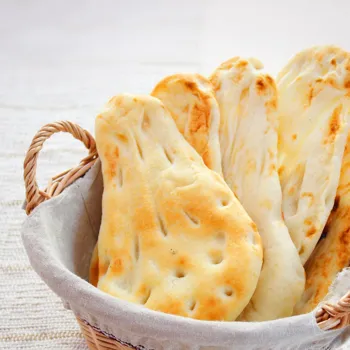
Don’t compromise on quality; it's the foundation of perfect naan, and elevates the taste.
Kneading dough properly is crucial for light, airy naan
Proper kneading is essential for the dough's elasticity and structure. The gluten development during kneading creates a network that traps gases, resulting in a light and airy naan. Insufficient kneading leads to dense flatbread.
Dedicate time and attention to this step; it's the key to the perfect texture.
Warm environment aids dough fermentation, key for fluffy naan
The environment plays a vital role during proofing. A slightly warm place encourages fermentation. When yeast works, allows dough to expand, also contributes rich flavour in naan. So cover the dough avoid dryness during the crucial rising phase.
Scorching pan essential for crispy naan texture
A scorching pan is necessary for achieving the distinctive blistered texture of naan. The quick burst of heat sears the surface, creating those desirable charred spots. Regulate the heat to get crispy blistered texture. Don't skip this step.
Experiment with flavor to create signature naan
Naan's versatility extends beyond basic flavors. Infuse the dough with herbs, spices, garlic to enhance your aroma. Create your signature naan. Have fun to Experiment flavor create your own recipes.
AI Generated Content. Glance/InMobi shall have no liability for the content